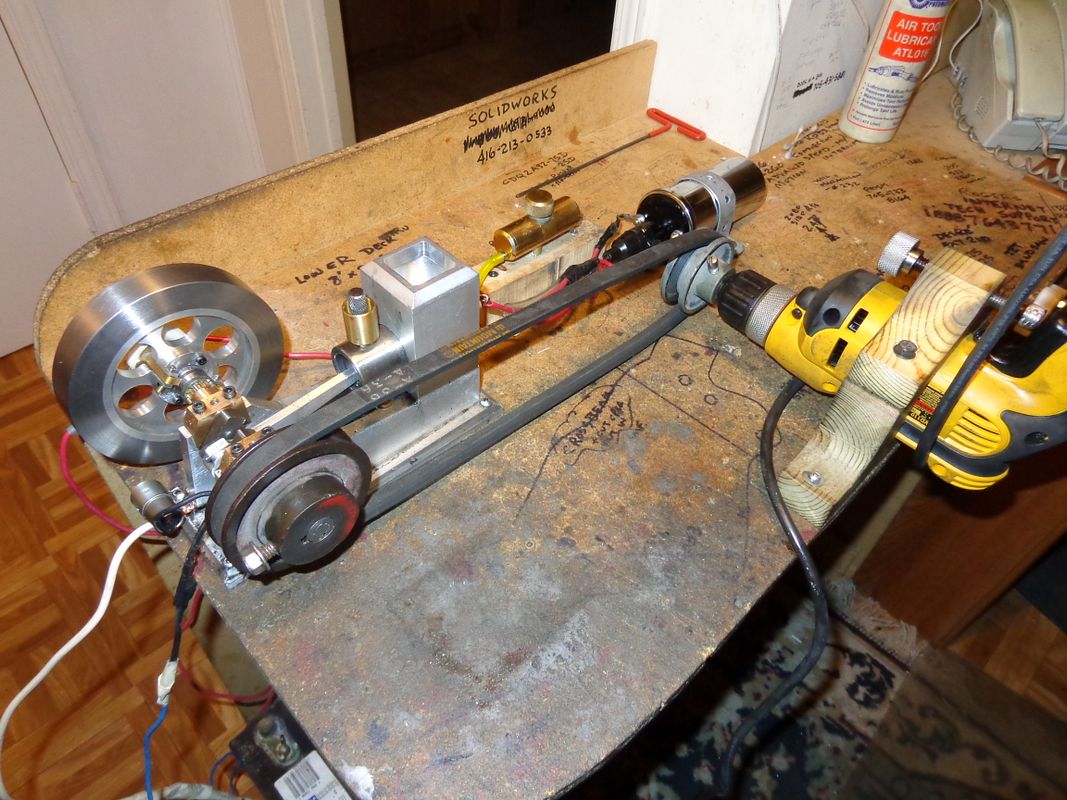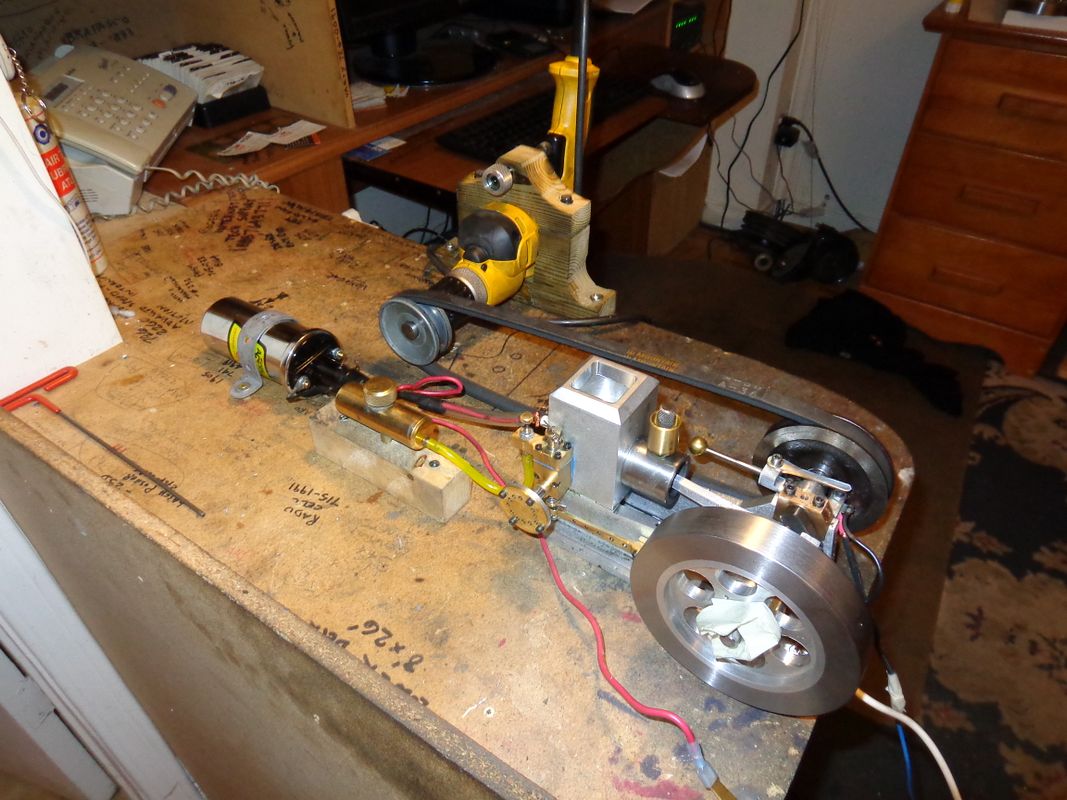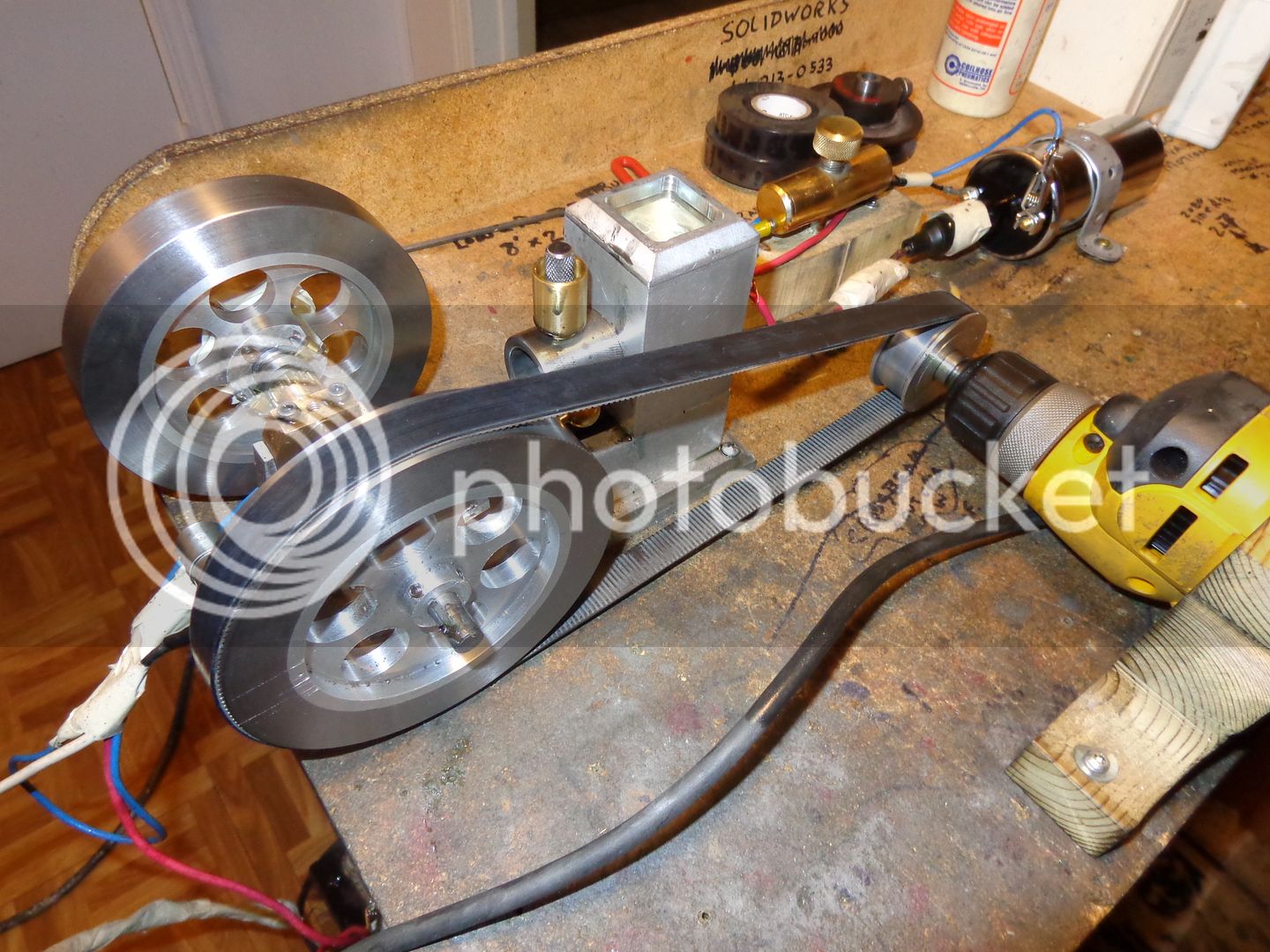I'm not sure that congratulations are called for yet----but thanks. You kind of have to picture this.---Engine is bolted to my reference table in my office. The non-governor flywheel has been replaced with a 3" v-belt pulley. The electric drill has a 2 1/2" pulley mounted on a stub arbor. I want to see if the drill has enough guts to drive things this way, so I'm holding the drill in two hands with the belt loose, and just before I fire up the drill I figure "Oh Hell, may as well hook up the battery wire!!!" I start the drill, pull the belt tight, and the engine starts to turn over---and almost immediately starts to fire POP-POP-POP!!! This surprises me to no end, but I can't let go of the drill because it takes two hands to keep the belt tight. I let go of the drill with one hand to twiddle with the throttle valve, but then I can't keep the belt tight with only one hand on the drill, and the motor stops. I repeat this about 3 times--UNBELIEVABLE!!! Then I decide that I need to make a more stable set up with the drill bolted to the table in its "holder/stand (remember the sawmill video). Tomorrow may be an exciting day.
You are using an out of date browser. It may not display this or other websites correctly.
You should upgrade or use an alternative browser.
You should upgrade or use an alternative browser.
Philip Duclos "Odds N Ends" hit and miss engine
- Thread starter Brian Rupnow
- Start date

Help Support Home Model Engine Machinist Forum:
This site may earn a commission from merchant affiliate
links, including eBay, Amazon, and others.
canadianhorsepower
Well-Known Member
- Joined
- Oct 22, 2011
- Messages
- 1,671
- Reaction score
- 324
Congrat Brian Thm:
so you wont be POLL DANCING ****Rof}Rof}
so you wont be POLL DANCING ****Rof}Rof}
Hello Brian,
You've done a fine job to date so don't give up! If you have good compression, fuel at the carburetor and a good hot spark the engine should start reasonably easy. Have you checked the exhaust valve timing and the ignition timing. If it is pop-popping it could easily be ignition or valve timing. I would start with about 10 degrees advance on the ignition and about 50 degrees before BDC for the exhaust valve opening. Is the engine reasonably free at this stage? Will it bounce of compression?
Hope these tips help but you have probably addressed these issues by Now!
Cheers.
johwen
You've done a fine job to date so don't give up! If you have good compression, fuel at the carburetor and a good hot spark the engine should start reasonably easy. Have you checked the exhaust valve timing and the ignition timing. If it is pop-popping it could easily be ignition or valve timing. I would start with about 10 degrees advance on the ignition and about 50 degrees before BDC for the exhaust valve opening. Is the engine reasonably free at this stage? Will it bounce of compression?
Hope these tips help but you have probably addressed these issues by Now!
Cheers.
johwen
So here we are, all set up and ready to rock and roll tomorrow morning. Don't be alarmed about the rats nest of wires---I know where they all go, and they will all be tacked down and taped up before I try to start anything. ( I have been witness to loose wiring getting caught up in revolving parts before, and it isn't pretty!!!) Wish me luck!! See ya tomorrow.---Brian




aonemarine
Well-Known Member
- Joined
- Nov 18, 2012
- Messages
- 887
- Reaction score
- 212
Tune in tomorrow for another cliff hanger on "As the fly wheel turns".....
- Joined
- Aug 25, 2007
- Messages
- 3,890
- Reaction score
- 715
Sorry not to get back to you sooner, Brian, but congratulations on getting some results.
I've used a 90v DC motor powered by a variac to give me variable speed. I used micro size V-Belt, only about 3/16" wide and thick with a 1.25" home made pulley on the motor. Just wrapped the belt around the flywheel which is 5" in diameter. With the reduction, the engine was spinning at around 300 - 400 RPM.
Looks like what you've got will work fine. Only suggestion would be to get a smaller v-belt or use a flat belt, like a timing belt, that you can just wrap around the flywheel and use a flanged pulley on the motor to keep the belt tracking.
Once you get the motor running steadily, you can use the electric motor as a generator!
Chuck
I've used a 90v DC motor powered by a variac to give me variable speed. I used micro size V-Belt, only about 3/16" wide and thick with a 1.25" home made pulley on the motor. Just wrapped the belt around the flywheel which is 5" in diameter. With the reduction, the engine was spinning at around 300 - 400 RPM.
Looks like what you've got will work fine. Only suggestion would be to get a smaller v-belt or use a flat belt, like a timing belt, that you can just wrap around the flywheel and use a flanged pulley on the motor to keep the belt tracking.
Once you get the motor running steadily, you can use the electric motor as a generator!
Chuck

$519.19
$699.00
FoxAlien Masuter Pro CNC Router Machine, Upgraded 3-Axis Engraving All-Metal Milling Machine for Wood Acrylic MDF Nylon Carving Cutting
FoxAlien Official

$24.99
$34.99
Bowl Sander Tool Kit w/Dual Bearing Head & Hardwood Handle | 42PC Wood Sander Set | 2" Hook & Loop Sanding Disc Sandpaper Assortment | 1/4" Mandrel Bowl Sander for Woodturning | Wood Lathe Tools
Peachtree Woodworking Supply Inc

$39.99
$49.99
Sunnytech Low Temperature Stirling Engine Motor Steam Heat Education Model Toy Kit For mechanical skills (LT001)
stirlingtechonline

$99.99
AHS Outdoor Wood Boiler Yearly Maintenance Kit with Water Treatment - ProTech 300 & Test Kit
Alternative Heating & Supplies
![DreamPlan Home Design and Landscaping Software Free for Windows [PC Download]](https://m.media-amazon.com/images/I/51kvZH2dVLL._SL500_.jpg)
$0.00
DreamPlan Home Design and Landscaping Software Free for Windows [PC Download]
Amazon.com Services LLC

$40.02
$49.99
Becker CAD 12 3D - professional CAD software for 2D + 3D design and modelling - for 3 PCs - 100% compatible with AutoCAD
momox Shop

$94.99
$109.99
AHS Woodmaster 4400 Maintenance Kit for Outdoor Wood Boiler Treatment
Alternative Heating & Supplies

$45.99
Sunnytech Mini Hot Air Stirling Engine Motor Model Educational Toy Kits Electricity HA001
stirlingtechonline

$12.56
$39.95
Complete Plans for Building Horse Barns Big and Small(3rd Edition)
ThriftBooks-Atlanta

$89.99
Outdoor Wood Boiler Water Treatment Rust Inhibitor- AmTech 300 & Test Kit
Alternative Heating & Supplies

$29.95
Competition Engine Building: Advanced Engine Design and Assembly Techniques (Pro Series)
Amazon.com Services LLC
Chuck--I considered all the rotary power sources I have, and I don't have much!! I have the lathe, which is a possibility, but there is a lot of "secondary" stuff ---gas tank, coil, etcetera which have to be in close proximity to the engine. I have the electric drill in the picture plus a second battery powered drill, and an old 1725 rpm half horse electric motor that I bought at a yard sale. What I have cobbled up will work---I've already proved that to myself. Looking at it now, it would be nice to have built a lever type mechanism to slack off the belt once the engine begins to run under its own power, to isolate it from the drill motor. I know I could easily design and build something like that, but when you only build one or two engines a year, it hardly seems worth it. If I wanted to, I could probably fill my entire house with "One time use contraptions." I don't really want to go down that road. Once I get the engine running and firing with some regularity, I'll put the flywheel back on and revert to my "adapter" which fits in my battery operated drill and use that to start the engine. I'll have to check out the "micro sized" v-belt.
No joy yet. I did manage to go to the local vaccuum cleaner repair joint and find a nice flat belt so I can run it on my flywheel rather than on the v-pulley. I made up a flanged pulley from 2" round aluminum for the electrric drill. the engine definitly is firing and getting warm. Just not taking off on its own yet. I added some 2 stroke oil to the coleman fuel.


AussieJimG
Well-Known Member
- Joined
- Oct 17, 2010
- Messages
- 890
- Reaction score
- 118
If you have compression, and you still have spark under compression (when the required voltage is higher) and the intake valve is opening and you are getting fuel into the cylinder because it is washing away the lubrication then it HAS to be mixture - just thinking out loud as I am sure you have done.
Did you try EZY-start (or whatever it is called over there - it is sold as Start-Ya-Bastard over here)?
Jim
Did you try EZY-start (or whatever it is called over there - it is sold as Start-Ya-Bastard over here)?
Jim
Hi Jim---Yes, I've tried the "Quick start" but it doesn't have that much effect. I have all kinds of spark. Intake valve is cycling open and close---I can see it dancing when the motor is turning over, driven by the drill/belt arrangement. It kinda makes a noise like a duck farting when I turn the engine over by hand. Engine is firing, somewhat inconsistently, but not real badly as it is being driven. Trying to think of what I've done differently on this engine.--I am using cast iron rings for the first time instead of Viton o-rings, but that shouldn't be a factor--in fact, with the carb and valve body off, If I put my finger over the sparkplug hole and the inlet hole, it will bounce back when you flip the flywheel. My other hit and miss engine uses a home made carburetor. My webster and my Atkinson both use model airplane carbs. I am not really sure I have done a great job on the needle valve.--In fact I phoned all the hobby shops that I can get to to see if anybody had a needle valve with a #2-56 Imperial thread on it, but of course nobody did. I'm kinda stuck right now, not knowing what to do next. I was just taking a look at the valve body/carb on my Webster, wondering if it would fit this Odds and Ends engine. Probably a different bolt pattern, although the basic set-up is the same.
aonemarine
Well-Known Member
- Joined
- Nov 18, 2012
- Messages
- 887
- Reaction score
- 212
How much spring tension is on that points set?? Seemed to me to be a strange and maybe lite on the return, but im new to this.
Lots of spring tension there. Remember, thats a piece of tempered steel hacksaw blade.--If it wasn't working properly, I wouldn't have good spark at the sparkplug.How much spring tension is on that points set?? Seemed to me to be a strange and maybe lite on the return, but im new to this.
starnovice
Member
- Joined
- Nov 21, 2010
- Messages
- 194
- Reaction score
- 23
A "out of the blue" thought just in case it generates a sensible thought -- maybe you can use double sided tape to stick one of your other carbs on just to test your theory about the needle valve.
Good luck we are all rooting for you.
Good luck we are all rooting for you.
The engine is spinning quite freely now after all of this running trying to get it started. I do notice that when I block off the intake and exhaust ports with the fingers of one hand and flip the flywheel with my other hand, I can hear some air escaping out the end of the cylinder. This would never happen with viton o-rings. Could be that there is just enough compression lost past the cast iron rings to prevent ignition??? I have just checked, and the entire valve body and carb off the Webster (which I know runs good) will fit right onto this engine if I tapped two more holes in the water jacket/cylinder. I have checked everything else, and now I'm looking at alternate 'fixes' to get up and running. I have the choice of machining a new piston with a Viton o-ring, which would absolutely stop any air loss past the piston, or---I could mount the whole valve body/manifold/carburetor set up off the Webster onto this engine to prove/dissprove any thoughts about compression loss at the valves, or the efficiency of my home made carburetor. (The one on the Webster is a Traxxas airplane carb).
aonemarine
Well-Known Member
- Joined
- Nov 18, 2012
- Messages
- 887
- Reaction score
- 212
Be nice if you could just take a piece of rubber and clamp it on rather than having to drill and tap holes...
canadianhorsepower
Well-Known Member
- Joined
- Oct 22, 2011
- Messages
- 1,671
- Reaction score
- 324
I can hear some air escaping out the end of the cylinder. This would never happen with viton o-rings. Could be that there is just enough compression lost past the cast iron rings to prevent ignition
I think you might have to use a leak down tester for accurate reading. If you dont have one take your comp/ratio x 14.7
ex 5.1= 5x14.7=73.5 lbs
pring your piston down both valve close and put 73 or close lbs of air in your cylinder were your spark plug is.
use the old soap and water "if needed" to find your leak
good luck
aonemarine
Well-Known Member
- Joined
- Nov 18, 2012
- Messages
- 887
- Reaction score
- 212
Pull the piston and inspect the ring for wear pattern?? The fact the compression came up when you put oil in it is a good indicator that the ring wasnt sealing, but I would have expected it to seat in after a bit... Man these engines are only 5:1 c/r??
I need to build one just so I can share the pain....
I need to build one just so I can share the pain....
jixxerbill
Well-Known Member
- Joined
- Jan 11, 2013
- Messages
- 114
- Reaction score
- 24
Just thinking out loud here but I would hold off on mounting another carb and check compression more. Reason I'm think that is if you used starting fluid and it didnt make much difference, I would lean more towards a compression problem. Just a thought, I have used starting fluid more times than could be counted and if everything is good except fuel it will actually run of of starting fluid. It's not good for them to run on it but it will do it. Wishing you luck. Bill.
Similar threads
- Replies
- 356
- Views
- 66K
- Replies
- 394
- Views
- 79K





































![MeshMagic 3D Free 3D Modeling Software [Download]](https://m.media-amazon.com/images/I/B1U+p8ewjGS._SL500_.png)









